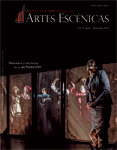Authors
Abstract
The content of this article is a recount of how “The Devotee” character was created in the stage work “If the River Spoke…” An important objective was the creation of a refl ection of the actor-creator in a Collective Creation process which is the form of working used by La Candelaria theater group. On the other hand, it is also an objective to show the panorama that links Collective Creation with the actor or actress creative work; this is to say the development and creation of the play in all dimensions, the formal, the technical, the thematic, the artistic in relation with the character creation that makes up the play.
Like all plays from La Candelaria Theater, this staging also shows a metaphor of our social reality, reason why the artist creator is forced to develop a theoretical and practical research process on which the creative experience is supported so that, when placed in relationship with the audience, the result of the aesthetic objectives proposed at the beginning of the process can be determined. This article is aimed at artists from performing arts, students
in training, critics, scholars and theater researchers who are interested in knowing how Collective Creation works from this group that, since its inception has been interested in creating their own theater art, a national theater art.
The play was created following the usual method of collective creation used by the group: initially the process is determined by the topic of interest to be investigated that is developed in a theoretical and practical way, specialized chats and conferences, writt en material, movies, etc., which allows documenting the proposed topic. In the practice, the process is developed by means of a fundamental tool: improvisation.
Thus, the writing is elaborated through a description of the general process of the play: materials consulted narration of improvisations, creation of scenes, organization of the play, and gets into the creation of the character through a refl ection that involves dialogue selection, referents consulted, formal intentions, etc. This way, an analysis of the process followed by the group in the making of a play, the creation of “The Devotee” character made by the actress, and the research addressed to reach the fi nal result of the created play, in this case “If the River Spoke…” can be accessed
The topic of the play is violence in Colombia from the perspective of extermination. Within this context, “The Devotee” character is constructed as a heroic, compassionate and religious woman who is at the same time a pagan woman. The refl ections presented in the article lead to a continuity in the thoughts on how the roads of theatrical creation are built, taking into consideration that there are not preestablished formulas on this aspect. Moreover, relating the country social reality with the artistic creations is a way to generate refl ection from the recipients and additionally changing those experiences into academic consultation materials, contributes to create Colombia’s own Theater Movement theories.
References
De Aguiar e Silva, V.M. (1982). Teoría de la literatura. Madrid: Gredos.
De la Hoz Simanca, J. (2012, 28 de julio). La mujer de las 5.000 autopsias. El Tiempo.com.Recuperado de
http://m.eltiempo.com/gente/la-mujer-de-las-5000-autopsias/12073244
Escobar Aillón, A., González Reyes, N., & Badillo Pérez, César. (2013). Si el río hablara.Inédita. Bogotá, Colombia.
Escobar, F. (2008, 30 de noviembre). Antígonas en Colombia. Elespectador.com. Recuperado de http://www.elespectador.com/impreso/
articuloimpreso94943-antigonas-colombia
García Pinzón, S. (1994). Teoría y Práctica del Teatro. Bogotá: Ediciones Teatro La Candelaria.
La Verdad Abierta. (2012, 12 de abril). La finca La Graciela: un ‘cementerio’ bajo agua. Recuperado de http://www.verdadabierta.com/victimas-seccion/desaparecidos/3971-lafinca-la-graciela-un-cementerio-bajo-agua--sp-1379771651
Nieto, P. (2012). Los escogidos. Medellín: Sílaba Editores.
Rodrigo Burón, D. (2013, 30 de enero ). El origen del teatro épico. Fundamentos para una práctica. Revistascientiahelmantica.usal.es
Rodríguez Adrados, F. (s.f.). El héroe trágico. Recuperado de http://interclassica.um.es/var/plain/storage/original/application/c156becb18da5cd94da4bea637b8a55f.pdf
Varley, J. (2008). Piedras de agua. Lima:Editorial San Marcos E.I.R.L.

 PDF (Español)
PDF (Español)
 FLIP
FLIP









